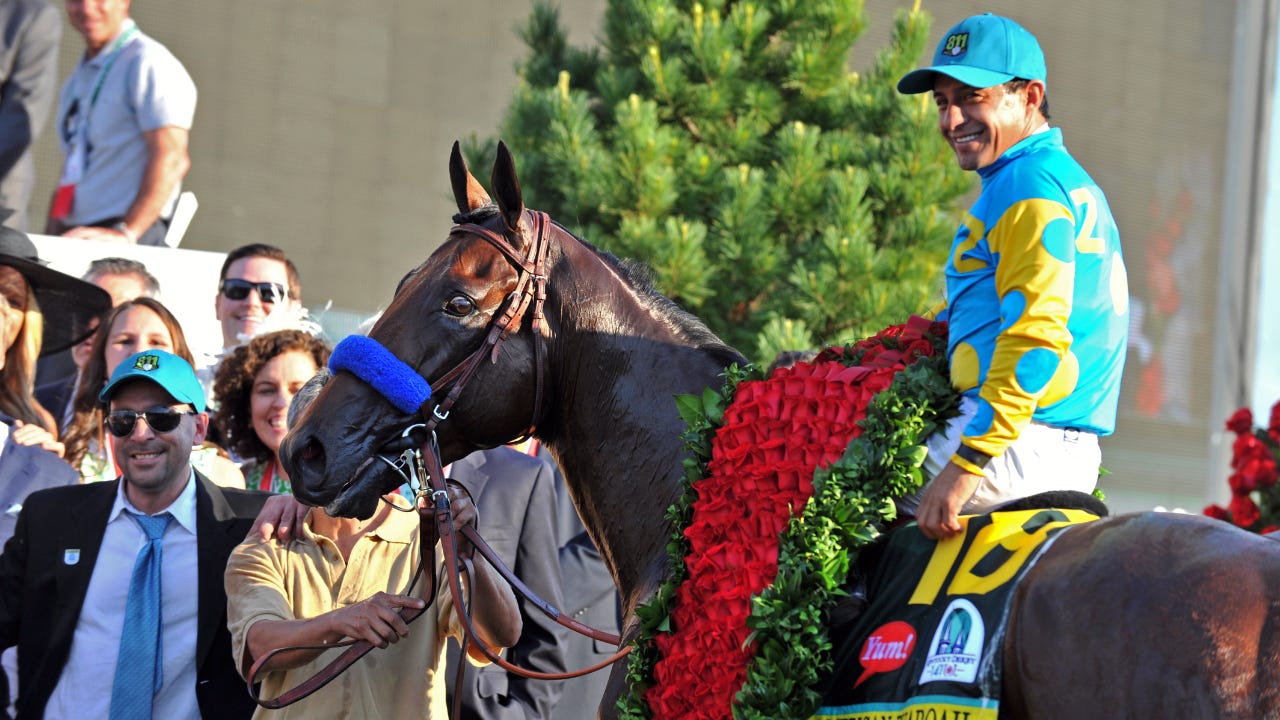How to invest in a racehorse: What to know before buying shares and how much it costs

As horse racing fans around the world get ready to watch the 150th running of the Kentucky Derby on May 4, many millions of dollars will once again be wagered on the horses to win, place or show. While gambling is woven into the history of horse racing, it’s not the only way to profit off thoroughbreds.
Investing in and owning racehorses is an extremely risky endeavor, but one that can hold riches for the few that are successful. Major races pay out significant sums in prize money and successful horses can have breeding value long after they’re done racing. But the costs associated with racing a horse or owning a stable are significant.
Here’s what you should know about investing in racehorses.
The history of investing in horse racing
People have been racing horses long before they started drinking mint juleps and wearing giant hats while sitting in “millionaire’s row.” Our collective fascination with horse racing dates back centuries, with the first organized horse races in North America said to have taken place in 1664 in what is now New York City.
In those early days, races focused on a horse’s stamina instead of its speed as they do today. It wasn’t until after the Civil War that races shifted to highlight the speed of the animals. Early races also tended to be match races, which took place between just two or at most three horses. As the sport grew, race fields expanded to include a larger number of horses.
Owning a racehorse has mostly been an activity of the wealthy due to the significant costs associated with housing and training the horses, but there are some options for smaller investors looking to make a fractional investment in a horse.
Most racehorse owners have significant wealth or come from families with long histories in the sport. Queen Elizabeth II was a huge horse racing fan and members of the British royal family own several horses that compete. Similarly, members of Dubai’s royal family also own horses that have won many races all over the world.
One racehorse owner who got his start investing in more traditional assets is Seth Klarman, founder of The Baupost Group, a hedge fund based in Boston. Klarman generated his wealth by investing in undervalued securities and even wrote a book called Margin of Safety that is considered one of the best investment books of all time. Klarman’s horse, Domestic Product, will be competing in the 2024 Kentucky Derby.
Buying a racehorse
Racehorses are typically bought at public auctions before they’ve run in any races at all, according to Stroud Coleman Bloodstock, an international thoroughbred agency based in the U.K. The lack of racing performance makes due diligence on the horses and a deep understanding of the industry a crucial part of the investment process.
Horses can be bought as foals, yearlings (one-year olds) or two-year olds. They can even be bought and sold once their racing careers have begun, but that could make successful horses significantly more expensive because they have a proven track record.
Lexington, Kentucky-based Keeneland is one of the most prestigious thoroughbred auction houses in the world and conducts several auctions each year. At its September 2023 yearling auction, nearly 2,900 horses sold for an average price of $141,489. The most expensive horse was purchased for $3 million.
Costs can vary depending on the age of the horse and whether it’s already demonstrated success in racing. Yearlings are generally cheaper than 2-year-olds because as the horses age, it becomes easier to determine whether they’re likely to have racing success. Prices decline for older horses who are past their racing primes, unless they’re likely to have significant value as studs, which is only the case for the most successful horses.
But the cost doesn’t end with your initial purchase. Ongoing costs can run quite high for training, travel, veterinary costs, stables and more. You can expect to spend between $30,000 and $50,000 per horse annually on these costs, according to Horse Racing Sense, a blog devoted to the horse industry. Trainers typically charge day rates, which can run between $60 and $120 or even more, depending on the person and facility, according to Horse Racing Sense.
Owning part of a racehorse
If these prohibitive costs put buying an entire racehorse out of reach, there are still other options to consider. New platforms, such as MyRacehorse, allow investors to purchase shares in horses similar to the way some online brokers allow you to buy fractional shares of stock. By breaking down the ownership into shares, it makes investing in racehorses accessible to more people.
Profile page of Chasing Time from the MyRacehorse stable. (via MyRacehorse.com)
You can buy shares for around $100 or less, but that will only get you a 0.01 percent stake in the horse. A 1 percent stake will typically run closer to $10,000. For example, shares of Balletic, a 2-year-old filly trained by hall of fame trainer Todd Pletcher, were available in 2022 starting at $80 for a 0.01 percent stake. You can also purchase interests in horses through partnerships sold by well-established stables such as West Point Thoroughbreds or syndicates such as Pocket Aces Racing.
Beyond the potential winnings, you may also get special access to the racetracks and get to meet the trainers, jockeys and horses. Some stables also host events for their members and investors, allowing you a greater chance to participate in the lifestyle of horse racing.
The shares approach can also allow you to spread your money across multiple horses, possibly increasing the chances of earning a payout. Keep in mind that investing in racehorses is extremely risky and most horses do not generate much in the way of prize money. But if horse racing is your passion, buying shares in a thoroughbred can be a way to get some skin in the game.
Is investing in a racehorse profitable?
As mentioned, investing in racehorses is extremely risky and isn’t likely to be profitable for most investors. However, for a very small number of investors who own or have a stake in a successful horse, the winnings can be substantial.
Investing in racehorses can best be thought of as a lifestyle investment. If it’s a sport you love and something you’re passionate about, you may get some enjoyment out of the investment beyond the profits or losses you generate. Horse racing is sometimes referred to as the sport of kings, so investing in it yourself can make you feel like royalty. Just be sure to understand the risks involved and that the odds for success are long.
Millions of dollars are available in prize money each year for racehorses. The purse at the Kentucky Derby alone is estimated to be $5 million this year, with the winner taking home $3.1 million. But remember, only one horse wins that race out of the thousands that are bought at auctions with hopes for major racing success.
After considering all the costs associated with owning a horse, most investors will not earn a profit on their investment, or even get their money back. Just a few winners will win big and they typically have access to significantly greater resources than the small-time investor.
If you are fortunate enough to make it big, you can also earn money in the form of breeding fees once the horse is no longer racing. The most successful horses can earn a lot in those fees because investors hope the horse’s pedigree will produce more winners in the future.
Fusaichi Pegasus, who won the Kentucky Derby in 2000, was sold for between $60 million and $70 million and initially commanded stud fees of $200,000 to breed. The fee was reduced to $7,500 in 2020, according to Horse Racing Sense.
2015 Triple Crown winner American Pharoah reportedly earns a stud fee of $200,000, while Tapit, who has sired horses that have gone on to earn more than $198 million in racetrack earnings, gets $300,000 for breeding. Tapit is considered the most successful sire in North American history.
Of course, you’ll have to pay taxes on any income you earn as a result of your racehorse investments. Be sure to understand the IRS rules on passive investments, because you may not be able to deduct losses you generate if the investment is classified as passive. If you own the horse as part of a partnership, you’ll also receive a Form K-1 where you’ll report income and losses as part of your personal tax return.
Pros and cons of investing in a racehorse
Pros
- Lifestyle investment and lifelong hobby
- Potential for big profits
- Develop relationship with horse and people involved in training/upkeep
Cons
- Expensive to get started
- Financial success is rare and most investors lose money
- Ongoing costs are high for trainers/travel/vet and management fees can be high for fractional interests.
Digital horse racing
Recently, a growing segment of people have shown interest in digital horse racing through platforms such as Zed Run. The platform uses virtual horses that are NFTs, or non-fungible tokens, and their owners can compete in simulated races and even breed their horses as a way to earn money. The races are based on an algorithm that generates 10,000 different random races and then chooses one for that specific race.
via Zed Run
These digital horses can be purchased on the platform using cryptocurrency (you can find plenty of horses for less than $50, while others will cost millions). Races, which can be entered for small fees, are run several times throughout the day. Some think digital horse racing will be the first major sport in the metaverse.
Bred horses gradually lose their breeding ability the more offspring they produce, while so-called Genesis breed horses have unlimited breeding ability. There will only ever be 38,000 Genesis horses in the Zed ecosystem, according to Zed Run.
Bottom line
Investing in racehorses is a risky endeavor that’s unlikely to be profitable for the majority of investors. But if the sport is a passion of yours and you can afford to make a lifestyle investment with a low or nonexistent expected return, it can be a fun hobby. With shares of horses now available, it is easier than ever to make an investment.
If you’re looking for more traditional investments, such as stocks, mutual funds and ETFs, here are some tips for how to get started.
Editorial Disclaimer: All investors are advised to conduct their own independent research into investment strategies before making an investment decision. In addition, investors are advised that past investment product performance is no guarantee of future price appreciation.






